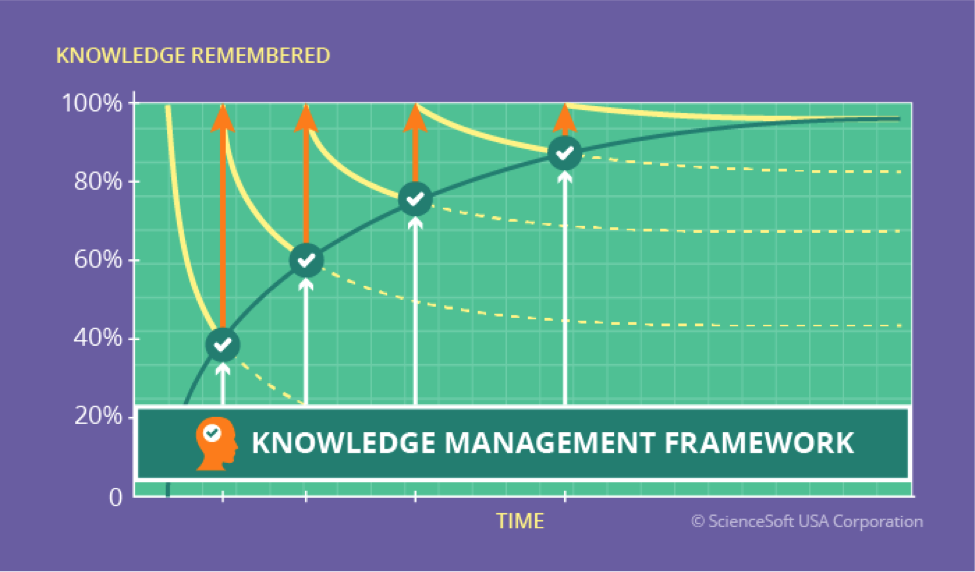...
How would you like to be a Guest Blogger for KMI? Email us at: info@kminstitute.org and let us know your topic(s)!
Controlling the Forgetting Curve with a Knowledge Management System
With billions spent on corporate training yearly, companies just can’t afford for employees to forget knowledge they gain. A knowledge management system is what can help organizations to anticipate forgetting and break the forgetting curve.

Summarizing the results from 2016, the Training Industry Report shows that the total training expenditure in the USA reached $70.65 billion. With such substantial investments into corporate learning, companies definitely expect employees to retain acquired knowledge and use it actively. However, the human memory isn’t perfect and Ebbinghaus’ forgetting curve proves that well. Regardless of how interesting and useful a training session is, a month later employees will tend to remember not more than 20% of the knowledge learned.
Usually addressed within corporate learning, the forgetting curve problem also permeates into knowledge management. Therefore knowledge managers should search for appropriate tactics to stop the forgetting process, stabilize new knowledge and make it stick in the corporate memory. To add a practical touch to the topic, below there are possible ways to crush the forgetting curve with a tailored SharePoint-based knowledge management solution.
Self-learning and Individual Training
When employees choose self-learning or individual training, they are often left to their own devices. While gaining important knowledge through personal research or participating in a training session, employees rarely report on the knowledge they got. If there are no adopted practices of sharing such knowledge, or there is no need in using it regularly, most likely this knowledge will be lost in the near future.
To prevent this, companies can use a KM system to control knowledge acquired individually and let it become a part of their corporate knowledge. A customized tech tool will give employees the opportunity to manage their knowledge as well as collaborate with a knowledge manager.
Knowledge pages to track individual knowledge statuses
Personal knowledge pages will allow employees to assess the current state of their knowledge by listing their explicit and tacit knowledge items and looking up their self-learning and training history. The history can include latest training subjects, the date of training and the expected review date. The knowledge that is located in a risky forgetting zone can be highlighted, so that employee could see it upfront and plan the review according to the workload.
Customizable notifications to review ‘fresh’ knowledge
Provided with the opportunity to set personalized notifications, employees will get an alert asking to review recently learned information. Relying on Ebbinghaus’ forgetting curve timeframes, notifications can be adjusted for the 2nd, 6th and 31st day after self-learning or individual training.
Timely reviews with a knowledge owner
If an employee got new tacit knowledge personally while communicating with a knowledge owner, a KM system can help to anticipate forgetting tacit knowledge. Just like above, employees can arrange a review meeting either 6 or 31 days after the first explanation. If some knowledge gets lost, a knowledge owner helps to restore it.
Tests to check knowledge stability
To assess how well particular knowledge is retained, employees can take a relevant test to check their knowledge stability. For example, this approach can be used by line or knowledge managers to test those employees who completed an in-house training. Test results can be shown on a knowledge page so that employees could compare the same test through different periods of time and understand if an additional review is required.
Team learning
If a company organizes a team training, even a bigger challenge arises: several employees should retain the same knowledge equally well. In this case, a KM system can help teams to support the required level of knowledge using different knowledge management tools.
Team spaces for knowledge review. If the entire team participates in a training session, it will be useful to provide them with dedicated team space where they can collaborate, discuss training materials, ask questions, clear up complex issues and more. After several reviews in a KM system, employees can arrange a final live collaborative review to retain knowledge better.
Team notifications. As soon as a critical moment for a knowledge review comes, each team member will get a relevant notification. Then, team members can arrange knowledge reviews aligned with their timetables using their team space. Notifications can also be coupled with a specialized form for employees to mark out questions they want to discuss during an upcoming live review. This will help participants to make the review more productive.
Reviewing workflows. This option can be particularly valuable for knowledge managers. Creating a dedicated reviewing workflow, a knowledge manager will be able to check knowledge of each team member one by one. As soon as all employees review the required materials and pass relevant tests, a KM will be notified about the reviewing cycle completed to analyze the results of each employee.
Knowledge adoption gets manageable
Traditionally, KM systems help organizations to structure knowledge, make it uniform and easily accessible for employees, as well as to put into practice a centralized KM strategy. At the same time, knowledge management software can also become a knowledge manager’s tool to monitor how well new knowledge is implanted, thus control the forgetting curve. Using specialized features, a knowledge manager can:
- Initiate knowledge reviews. A knowledge manager can see the knowledge that wasn’t reviewed within the required timeframe and invite employees to brush it up with a relevant notification.
- Assess knowledge retention. Analyzing test results, a knowledge manager can understand how well employees capture new knowledge. If the forgetting curve is still deeply concave, a knowledge manager can then reconsider the effectiveness of reviewing techniques, initiate a more strict reviewing policy and offer alternative learning methods to achieve better results.
- Rethink a training program. By assessing knowledge retention after particular training sessions, a knowledge manager can exclude less effective training programs that are characterized by the most explicit forgetting curve.
Employee motivation matters
Unless employees have to refresh knowledge to solve a particular task, knowledge reviews are pretty often unpleasant. At the same time, without a well-established reviewing process, companies will continue losing substantial investments into corporate learning.
Although the described KM tools can be helpful in overcoming the forgetting curve, obviously, it can still be difficult to control bulk reviews on the regular basis. To make things go easier, it’s always reasonable to motivate employees to make timely reviews willingly, be proactive and review for knowledge without any enforcement.
One of such incentives can be going for a mobile app with review exercises, to let employees reanimate their knowledge at any time with their mobile devices. This complements the KM approach described above in a way that employees can get points for regular knowledge reviews, to be reflected on their knowledge pages. These points can be later transformed into tangible corporate perks.
 About the Author Sandra Lupanava is a SharePoint Evangelist at ScienceSoft, a software development and consulting company headquartered in McKinney, Texas. With her 5+ years in marketing, Sandra voices SharePoint’s strengths to contribute to the platform’s positive image as well as raise user adoption and loyalty. Today Sandra advocates harnessing SharePoint’s non-trivial capabilities to create business-centric, industry-specific innovation and knowledge management solutions.
About the Author Sandra Lupanava is a SharePoint Evangelist at ScienceSoft, a software development and consulting company headquartered in McKinney, Texas. With her 5+ years in marketing, Sandra voices SharePoint’s strengths to contribute to the platform’s positive image as well as raise user adoption and loyalty. Today Sandra advocates harnessing SharePoint’s non-trivial capabilities to create business-centric, industry-specific innovation and knowledge management solutions.
Archives
- April 2024 (4)
- March 2024 (4)
- February 2024 (4)
- January 2024 (3)
- December 2023 (2)
- November 2023 (2)
- October 2023 (3)
- September 2023 (3)
- August 2023 (6)
- July 2023 (4)













